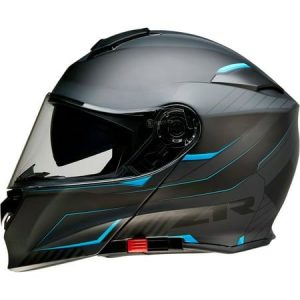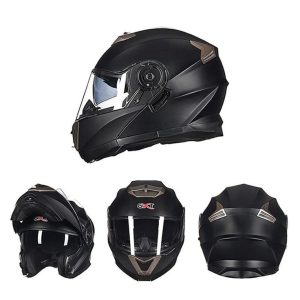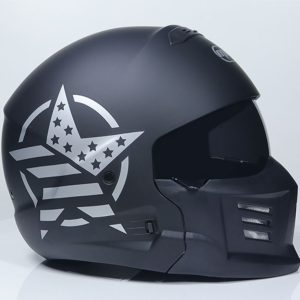Jun 7, 2024
What helmets do pro motorcycle riders wear?
What helmets do pro motorcycle riders wear? Professional motorcycle racing is an exhilarating sport that demands peak performance from riders and their machines. Safety is paramount, and helmets play a vital role in protecting riders in the event of a crash. In this article, we’ll explore the world of professional motorcycle racing helmets, examining the features, technologies, and certifications that keep riders safe.
Safety First: The Essential Role of Helmets
Motorcycle helmets are designed to absorb impact and protect a rider’s head during a crash. They are constructed from high-strength materials such as fiberglass, carbon fiber, or Kevlar, with a padded inner liner for comfort and additional impact absorption.
Professional motorcycle racing helmets meet the most stringent safety standards. These helmets are rigorously tested to ensure they can withstand the high speeds and forces encountered on the racetrack.
Types of Professional Motorcycle Racing Helmets
There are two main types of helmets in professional motorcycle racing:
Full-face helmets:
These helmets offer the most comprehensive protection, covering the entire head and face. They are the only type of helmet permitted in most professional motorcycle racing series.
Modular helmets:
Modular helmets, also known as flip-up helmets, offer the versatility of a full-face helmet with a movable chin bar that can be lifted for easier on and off. While not as common in professional racing due to potential safety concerns in a crash, some riders may use them in non-racing situations.
Features of Pro Racing Helmets
What helmets do pro motorcycle riders wear? Professional motorcycle racing helmets are packed with features designed to optimize safety, comfort, and aerodynamics:
-
Advanced shell materials: Helmets are constructed from lightweight yet high-strength materials like carbon fiber or a composite blend for superior impact protection without compromising weight.
-
Multi-density EPS liner: The inner liner of a helmet, typically made of expandable polystyrene (EPS), is crucial for absorbing impact energy. Pro racing helmets often use a multi-density EPS liner, with varying densities in different zones to provide optimal protection for different types of impacts.
-
Visor: The visor, or shield, protects the rider’s face from wind, debris, and insects. Racing visors are made from high-impact polycarbonate for strength and are often optically correct to minimize distortion. Tear-offs, disposable strips applied to the visor, are used by riders to maintain clear vision during races.
-
Ventilation system: A well-designed ventilation system is essential for keeping the rider cool and comfortable during a race. Racing helmets incorporate vents that allow air to flow through the helmet, removing heat and moisture.
-
Aerodynamics: Aerodynamics are crucial in motorcycle racing, affecting a rider’s stability and speed. Pro racing helmets are designed to be aerodynamic, minimizing wind resistance and drag.
-
Emergency release system: Some helmets come equipped with an emergency release system that allows medical personnel to easily remove the helmet cheek pads in case of a crash.
Certifications for Professional Racing Helmets
Professional motorcycle racing organizations have strict helmet certification requirements. Helmets used in professional racing must meet or exceed specific standards set by organizations such as Snell Memorial Foundation (Snell) or Fédération Internationale de Motocyclisme (FIM). These certifications involve rigorous testing to ensure helmets can withstand impacts and provide adequate protection for riders.
Beyond Safety: Additional Considerations
While safety is the primary concern, professional motorcycle racing helmets also consider comfort and functionality for riders:
-
Comfort: Riders wear their helmets for extended periods during races and practice sessions. A comfortable helmet with a snug yet breathable fit is crucial to prevent fatigue and distraction.
-
Weight: Lighter helmets are less strenuous on a rider’s neck and shoulders, especially during long races. However, lighter weight should not come at the expense of safety.
-
Visor options: Different visor tints and tear-off options are available to accommodate varying weather and lighting conditions racers encounter throughout a season.
-
Customization: Professional riders may have their helmets custom-painted with their personal designs or sponsor logos.
The Takeaway: Helmets for Peak Performance and Protection
What helmets do pro motorcycle riders wear? Professional motorcycle racing helmets are marvels of engineering, designed to offer superior protection, comfort, and functionality. They are a crucial piece of safety equipment that allows riders to push their limits on the racetrack with confidence.
While this article explores the helmets used by professional riders, remember that safety is important for all motorcyclists. If you ride a motorcycle, always wear a properly fitted helmet that meets safety standards. Choose a helmet that is comfortable and appropriate for your riding style.
Professional motorcycle racing is an exhilarating sport that demands peak performance from riders and their machines. Safety is paramount, and helmets play a vital role in protecting riders in the event of a crash. In this article, we’ll explore the world of professional motorcycle racing helmets, examining the features, technologies, and certifications that keep riders safe.
The Importance of Choosing the Right Helmet
Here are some key factors to consider when choosing a motorcycle helmet:
-
Safety certification: Look for a helmet that meets safety standards set by reputable organizations like the Department of Transportation (DOT) or the Snell Memorial Foundation (Snell).
-
Fit: A properly fitting helmet is essential for optimal safety and comfort. The helmet should feel snug but not constricting, and it should not move excessively when you shake your head.
-
Comfort: You’ll be wearing your helmet for extended periods, so choose one that is comfortable and breathable. Consider factors like ventilation and weight.
-
Riding style: Different riding styles may call for different helmet features. For example, touring helmets prioritize comfort and wind protection, while sportbike helmets may emphasize aerodynamics.
Resources for Finding the Right Helmet
Finding the right helmet is crucial for motorcycle safety. Here are some resources to help you in your search:
-
Motorcycle safety websites: Government agencies and motorcycle safety organizations offer resources on helmet selection and proper fit.
-
Motorcycle dealerships: Dealerships have trained staff who can help you find a helmet that fits you properly and meets your needs.
-
Online reviews: Reading reviews of different motorcycle helmets can give you valuable insights from other riders.
Conclusion: Ride Safe!
Whether you’re a seasoned rider or just starting out, choosing the right helmet is an essential part of motorcycle safety.




